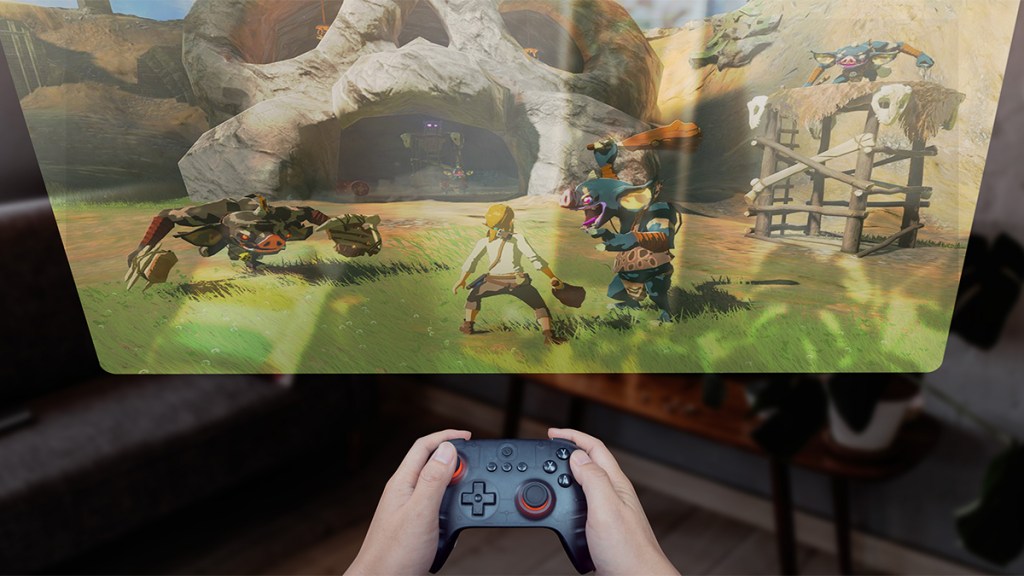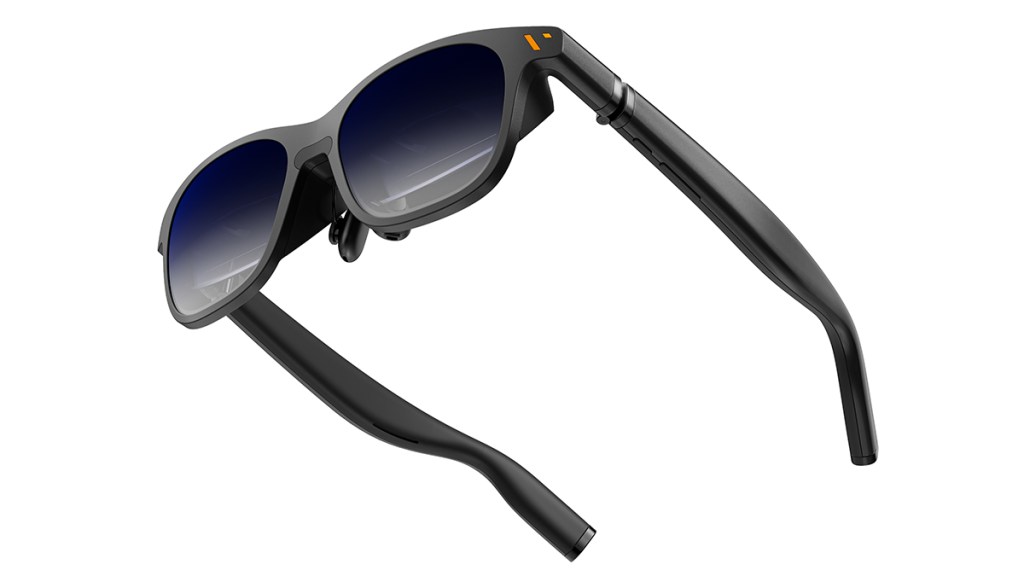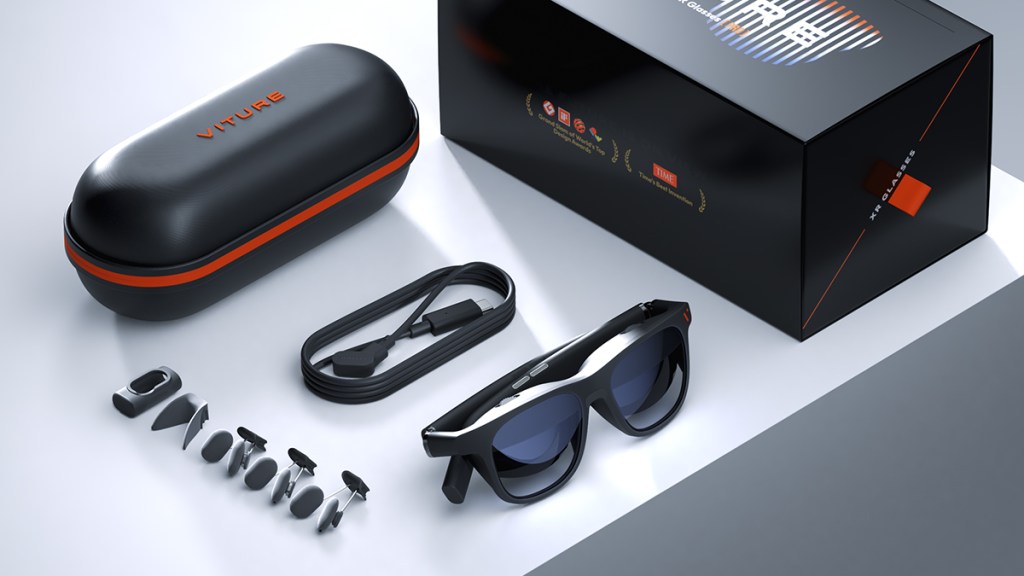As is the case for most products in this segment, the VITURE Pro XR glasses look fantastic on paper when it comes to specs and promised features. However, after being let down by one too many AR/XR solutions, I was very skeptical when I started my review process. Thankfully, following a month of use for both gaming and working, I’m happy to say that VITURE has delivered a compelling upgrade that is deserving of attention. This is my review.
Specs to die for
Where do I begin? The big feature highlight of the VITURE Pro XR glasses is the 135-inch virtual screen. With the upgraded 120 Hz support, users can enjoy super smooth visuals which are especially critical during gaming at higher frame rates. Additionally, the screen is capable of up to 4,000 nits of peak brightness, which is handy for use outdoors.
As someone who gets tired of using other AR and VR products after around an hour, it’s refreshing to use the VITURE Pro XR glasses for longer sessions without issue. Perhaps it’s the anti-glare, anti-ghost, and anti-motion sickness technologies helping me avoid headaches. Either way, I’m happy to say that I can comfortably use the Pro XR glasses over longer periods of time, especially with how relatively lightweight they are. If you’ve ever tried to work for multiple hours with something like the Apple Vision Pro strapped to your head, then you’ll know the value of cutting weight.

Setting up the Pro XR glasses is easy thanks to the included manual. The glasses can be combined with PCs, laptops, consoles, phones, and other devices. Now that most tech has moved over to USB-C, many devices will simply work by plugging and playing. As I’m reviewing this product for GameRevolution, I spent most of my testing time immersed in Alan Wake 2, Call of Duty, and Dave the Diver, powered by my PC.
Alan Wake 2 helped me test the visual and audio fidelity on offer, while Call of Duty tested input lag and how the glasses hold up in a competitive environment. As for Dave the Diver, that’s just the game that I’m currently addicted to, though the U.I.’s small font did put the glasses’ overall sharpness to the test. I also wrote up this review while using the glasses within Google Docs.
Enhancing the viewing experience

So the specs are impressive and it’s easy to set up and go, but is it actually any good? I’m happy to report that the VITURE Pro XR glasses get many things right. The big virtual screen is larger and crisper than much of the competition and remains sharp even at the corners. The 120 Hz is fantastic to see and helps bring the tech up to speed. Pair it with a PC or next-gen console and you can enjoy wonderfully smooth gameplay.
The glasses are comfy, too, which is a big win for this kind of technology. There are several nose pad options included in the box, though I found the default set worked best. Also, for those suffering from myopia (nearsightedness), adjustments can be made to the virtual image to make it clearer without the need for expensive prescription lenses.
There’s very little friction here, meaning I reach for the VITURE Pro XR glasses a lot more. What’s more, I can be both immersed in what I’m doing on the glasses and present at home, listening out for any family members wanting my attention. It’s the perfect middle ground for those who can’t afford to be fully immersed in VR.
Speaking of immersion, I simply must mention the “Electrochromic Film” that the glasses use. At the touch of a button, the transparency of the lenses can be blocked out and turned opaque. It’s quite magical.
Not quite perfect

While the VITURE Pro XR glasses have impressed me in most areas, there is still room for improvement. The main downside for me is the audio. While the quality is okay, the volume just isn’t loud enough for me. This could be due to VITURE prioritizing privacy and limiting audio bleed. However, for music, movies, or games, I’m grabbing my earphones.
The only other downside is to do with price, once other accessories are considered. Those looking to pair the VITURE Pro XR with gaming consoles like the Switch, PS5, or Xbox, and/or take advantage of 3D content, will need the Pro Mobile Dock. It’s an added extra that acts as a hub, taking an HDMI input and feeding it to the glasses.
While it’s cool that the Pro Mobile Dock also acts as a battery bank and supports up to two pairs of glasses, allowing multiple users to enjoy the same content on separate virtual big screens, it adds some extra steps. These steps take away from the seamless experience seen with phones and even the Steam Deck, where the glasses simply plug in and play. In fact, for Steam Deck owners, the VITURE Pro XR might be the perfect accessory.
Final Verdict
The VITURE Pro XR glasses will launch at $459 ($549 RRP). The Pro Mobile Dock will also be available for $129 ($159 RRP), which is needed for console owners. Additionally, the glasses, a dock, and a high-quality 8BitDo controller will be available as part of a bundle for $588 ($708 RRP). For the price, the experience feels polished and successfully enhances the viewing experience which, for someone like me who can’t afford or fit a 135-inch TV in my home, is a huge win. VITURE does a lot right with the Pro XR glasses and I think a lot of people will be interested in buying a pair.
Positives and Negatives
-
Impressive specs
-
Comfortable for long use
-
Easy plug-and-play setup with many devices
-
Sharp, clear visuals
-
Adjustable for myopia
-
Mandatory accessories for console gaming and 3D content push up the price
-
Audio volume could be louder
Disclosure: Review sample provided by VITURE.







